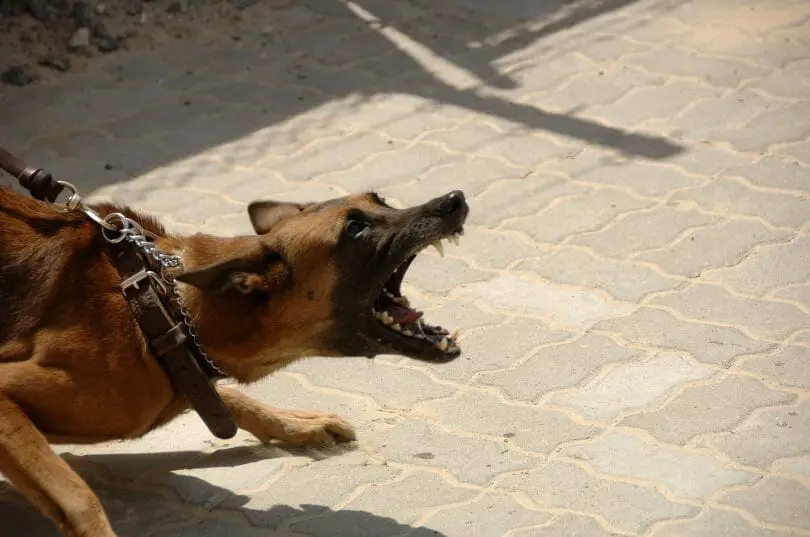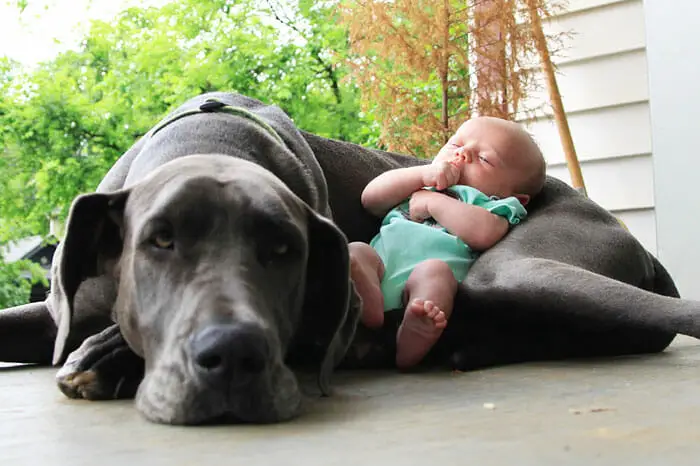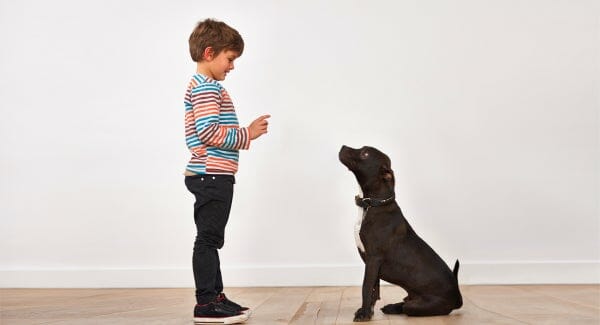Table of Contents
Owning a dog as a pet is all fun until it gets aggressive towards your baby. It can be scary to see your favorite pet being quite hateful and possibly hurt your baby in the process. It is important to understand the dog’s aggression after a new baby before being comfortable with the dog around your child. Sometimes it might be the simple things you do or the child does which irritate the dog. It is the irritation that leads to aggression.
Why Would a Dog be Aggressive Towards a Baby?

The dog’s aggression after a new baby can be triggered by many things. We will look at some of the aggression triggers below.
The smell
A baby will have a strong smell. It is an easily distinguishable smell that anyone would know that is a child. The problem is that dogs tend to have a strong sense of smell thousands better than that of humans. With the new baby scent, sometimes the smell can be overloading on the dog’s senses.
It is estimated that a dog possesses up to 300 million olfactory receptors as compared to humans who only have 6 million of similar receptors. It is why dogs can pick up scents better.
Sound
Other than being able to smell better, dogs can also hear better especially the high-pitched sounds. A dog can hear within a frequency range of 40 to 60,000 Hz, while for a human that range is 20 to 20,000 Hz.
A baby is likely to cry most of the with a high-pitched sound. With the high pitch, a dog is likely to get excited and misinterpret such sounds to a prey. Any tiny squeals from a baby will get the dog excited all for nothing.
Babies like to stare
Dogs always stare into their competitors in the eye in the wild to assert dominance. As we all know, babies can give you quite the stare. Whenever they stare too long at a dog, it might think it is a sign of confrontation.
It is not just for babies, but also adults. For a dog that you do not know or rarely get social with, staring at it might seem threatening to it. With a baby, it is worse because your baby has no idea that he or she is provoking the dog.
Baby movements
Babies sometimes can be quite the unpredictable lot. They will run around, squeal, raise hands, and so much more. Such movements might not be ideal when around a dog. It might get confused not knowing how best to interpret the behavior. The worst is when children run around stepping on the dog’s tail. This is always going to make your dog more aggressive.
Unfamiliar face
For a dog that has not been around babies before, their unfamiliarity might cause a problem. Babies smell strange, make strange noises, and sometimes their movement is erratic. At this point, the dog might be confused and tries to be aggressive as a way of showing dominance.
For most dogs, whenever they see something new, they get curious, grab it, and drop it to see how it reacts. It might just do that around your baby, so be careful with it.
Jealousy
Can a dog really get jealous because of a baby? Well, think of it this way, you have always been the center of attention, but suddenly that changes when the baby comes along. The parents now spend more time with the baby than you. This results in differential treatment. Well, it is easy to see why a dog might get jealous of the baby and hence show aggression.
Type of breed
What you need to understand is that some dogs might be good around kids while others not so much. The next time you seek to adopt a dog, make sure it is one that can behave well around kids. Talk to the animal shelter staff to help you understand what type of dog you are getting to avoid putting your child at risk.
Types of Dog Aggression

The type of aggression is likely to vary from one dog to another and depending on the situation. So, what are some of the common aggression types to expect with a dog?
- Territorial aggression is the most common. This is when the dog defends its space in your home. It might see the baby as an intruder.
- Protective aggression on the other hand is when the dog protects the other members of its pack against a person or another animal. Such aggression is common with mother dogs who want to protect their puppies.
- Possessive aggression can be common too, if you tend to take away its food, chew toys, and other objects of value to the animal. Sometimes it is called resource guarding.
- Fear aggression is when the dog is fearful and tries to get away from its opponent. As much as it might be fearful, it will still attack when cornered.
- Defensive aggression is the opposite of fear aggression as the dog will remain defensive all the time rather than retreating. For such a dog, you should be careful how you approach it.
- Social aggression is when your dog reacts aggressively to various social situations. If the dog has not been properly socialized with other people and dogs, it tends to showcase this type of behavior.
There might be other types of aggression, but these are the major types. Learning about them helps you know how best to diffuse the aggression when it happens.
How to Fix the Dog’s Aggression Towards Children

When you recently introduced a new baby into your home, it is best to stop the dog’s aggression after a new baby. With a few steps, it should be possible to have the dog on its best behavior around your baby.
Never leave the baby and dog alone together
People tend to forget as much as a dog might be friendly, it is still an animal. It does not have any moral compass. This means you should never leave your dog and baby unattended at any time. Without proper monitoring of the dog and the baby, sometimes something simple can make the dog quite aggressive. It is important that you are present to deal with the situation.
Establish house rules
A dog would mostly get aggressive when children poke it around all the time. It is best if the children do not do this. Ensure that your children understand the importance of not disturbing the dog all the time. Also, no rough play with the dog. A dog is likely to get aggressive when the children are too rough on it.
Socialize your dog
As part of making it good around babies and people, it is best to have it properly trained and socialized. For a dog that spends most of its time outside tied up, you might find that it is too aggressive towards babies and adults alike. It is best if you introduce it to more people so that it remains comfortable and less aggressive.
Choose a breed that fits your lifestyle
There are many breeds that you can choose from, but sometimes we can get the wrong ones into our homes. Depending on a breed, each will have its own temperament. Some breeds are known to be good with kids and people generally. Others might be better for security rather than to play with around. Ensure that you understand this before picking up any dog from the shelter.
Teach the kids to ignore stray dogs
Sometimes kids tend to play with stray dogs that are untrained. Such dogs might end up causing harm when least expected. It is best if you they do not play with such dogs. The worst part is that such dogs would not be vaccinated and might end up causing diseases to your children.
How to Introduce Your Child to An Aggressive Dog

Before introducing your baby to an aggressive dog, you first have to understand how kids and dogs relate. If you did not know, children can often be threatening to dogs. Children are likely to make abrupt movements or high-pitched noises that can make a dog scared or defensive. Other things that might set off the dog include the squealing toys that your baby loves.
Dogs relate to humans in different ways. It sees adults as the alpha at the top. However, that is not the same for babies. They see them as tiny and not alphas as their parents. Whenever a baby tends to disturb the dog, it would get aggressive just to show dominance.
You still have to understand that some dogs do not just love kids. These are dogs that might have had less exposure to kids before. The worst is when a dog has a bad history with children. The presence of a child reminds it of the abuse it faced before.
Bottom line is that kids will not always relate better with dogs. As a result, you need to find ways of introducing them to each other before a nasty accident happens between them.
The video below talks of the tips to use when introducing your dog to a new baby.
Dog-proofing your child
- As a way of dog proofing your child, you need to supervise what he or she does around the dog all the time. You should never leave your toddler with a dog in the same room with no supervision. Your child is likely to disturb the dog to a point it gets aggressive.
- Most people think that a dog will not attack a child since their dog is sweet. Well, they are all wrong. Sometimes a dog might be in its own world and simply lashes out on your baby. By the time you get to your baby, it would have hurt him already.
- Start to teach your child on how to interact with the dog. Show your child the best ways to handle a dog such as stroking it around the neck, feeding it its treats, and much more. Teach the child that poking or pulling the dog is not okay.
- Let your child know that staring at the dog is not okay, especially in its face. Staring can often make the dog slightly aggressive as it would think it is a sign of challenge.
Child-proofing your dog
- You always have to ensure that humans have dominance over your dog even if it is your children. Let the dog be reminded who is the alpha in the home. You can do this by stepping up obedience training.
- Help your dog adjust before the baby arrives. Introduce it to baby bedding, baby furniture, and equipment. Once it gets used in such, then it would be easy for it to adapt to having a new baby in the home.
- Expose your puppy to more people and other dogs as it grows. At least, it would be able to love being around people even newborns.
- For a dog that has shown repetitive aggression towards kids, it is important that you seek professional help from a vet. Sometimes it could be something more wrong with the dog that needs treatment.
How to React When a Dog Injures a Child

As much as you might have tried to child-proof your dog, it might still end up hurting your child. So, how do you take care of a dog bite injury while at home.
- First, place a clean towel to cover the injury as a way to help any bleeding from going on
- Keep the injured area elevated
- Once the bleeding has stopped, go ahead to wash the bite with water and soap
- Apply a bandage to the affected area
- An antibiotic ointment might also be great to prevent further infection
Well, you should still consider going to the doctor for more medical attention. As much as many dogs will have had their vaccine shots to prevent spread of diseases, you can never be too careful.
Conclusion
A dog’s aggression after a new baby can be scary. Well, you should now be in a position to easily handle such behavior whenever it arises in your dog. Take your time to understand what is making the dog aggressive and try to deal with it. Always let your children know how to interact with the dog to avoid any cases of aggression from the dog.
